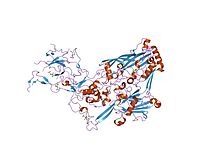| Adeno_hexon | |||||||||
|---|---|---|---|---|---|---|---|---|---|
 refinement of adenovirus type 2 hexon with cns | |||||||||
| Identifiers | |||||||||
| Symbol | Adeno_hexon | ||||||||
| Pfam | PF01065 | ||||||||
| InterPro | IPR016107 | ||||||||
| SCOP2 | 1dhx / SCOPe / SUPFAM | ||||||||
| |||||||||
| Adeno_hexon_C | |||||||||
|---|---|---|---|---|---|---|---|---|---|
 the quasi-atomic model of human adenovirus type 5 capsid (part 2) | |||||||||
| Identifiers | |||||||||
| Symbol | Adeno_hexon_C | ||||||||
| Pfam | PF03678 | ||||||||
| InterPro | IPR016108 | ||||||||
| SCOP2 | 1dhx / SCOPe / SUPFAM | ||||||||
| |||||||||
In molecular biology, the hexon protein is a major coat protein found in adenoviruses. Hexon coat proteins are synthesised during late infection and form homo-trimers. The 240 copies of the hexon trimer that are produced are organised so that 12 lie on each of the 20 facets. The central 9 hexons in a facet are cemented together by 12 copies of polypeptide IX. The penton complex, formed by the peripentonal hexons and penton base (holding in place a fibre), lie at each of the 12 vertices.[1] The hexon coat protein is a duplication consisting of two domains with a similar fold packed together like the nucleoplasmin subunits. Within a hexon trimer, the domains are arranged around a pseudo 6-fold axis. The domains have a beta-sandwich structure consisting of 8 strands in two sheets with a jelly-roll topology; each domain is heavily decorated with many insertions.[2] Some hexon proteins contain a distinct C-terminal domain.
Hexon directly recruits the cellular motor protein dynein in a pH-dependent manner.[3] The dynein-regulatory protein, dynactin, was found to play a clear role in regulating the dynein-adenovirus complex transport to the nucleus.
References[edit]
- ^ Athappilly FK, Murali R, Rux JJ, Cai Z, Burnett RM (September 1994). "The refined crystal structure of hexon, the major coat protein of adenovirus type 2, at 2.9 A resolution". Journal of Molecular Biology. 242 (4): 430–55. doi:10.1006/jmbi.1994.1593. PMID 7932702.
- ^ Rux JJ, Kuser PR, Burnett RM (September 2003). "Structural and phylogenetic analysis of adenovirus hexons by use of high-resolution x-ray crystallographic, molecular modeling, and sequence-based methods". Journal of Virology. 77 (17): 9553–66. doi:10.1128/jvi.77.17.9553-9566.2003. PMC 187380. PMID 12915569.
- ^ Bremner KH, Scherer J, Yi J, Vershinin M, Gross SP, Vallee RB (December 2009). "Adenovirus transport via direct interaction of cytoplasmic dynein with the viral capsid hexon subunit". Cell Host & Microbe. 6 (6): 523–35. doi:10.1016/j.chom.2009.11.006. PMC 2810746. PMID 20006841.
Well, that’s interesting to know that Psilotum nudum are known as whisk ferns. Psilotum nudum is the commoner species of the two. While the P. flaccidum is a rare species and is found in the tropical islands. Both the species are usually epiphytic in habit and grow upon tree ferns. These species may also be terrestrial and grow in humus or in the crevices of the rocks.
View the detailed Guide of Psilotum nudum: Detailed Study Of Psilotum Nudum (Whisk Fern), Classification, Anatomy, Reproduction